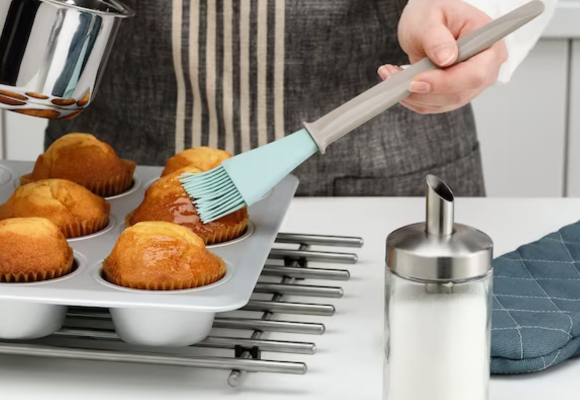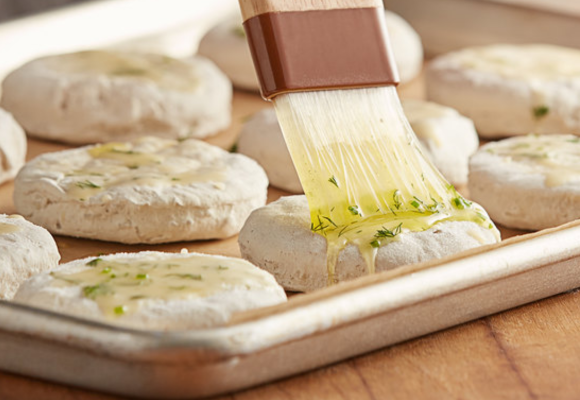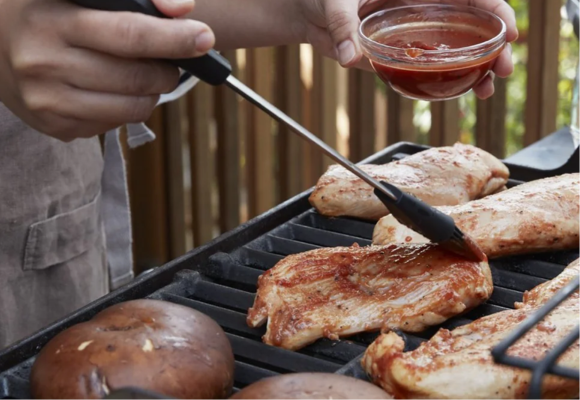When exploring the world of culinary tools, the subtle differences between seemingly similar items can be quite intriguing.
When it comes to the world of baking and cooking, the tools we use can significantly impact the outcome of our culinary creations. Among these tools, the basting brush and pastry brush often come up in discussions, both serving distinct purposes in the kitchen
This is particularly true when comparing a basting brush and a pastry brush.Understanding these differences not only helps in selecting the right tool for the job but also in achieving the best results in your cooking endeavors. Let’s find out the characteristics, uses, and benefits of each type of brush to understand their roles in a well-equipped kitchen.

What is a Pastry Brush?
A pastry brush, also known as a baking brush, is a small tool used in baking for applying liquids to various food items. Typically, it consists of a handle made from wood, plastic, or metal, and bristles that can be natural (like boar hair) or synthetic (like silicone). The design of a pastry brush is intended to be delicate enough to handle the finer tasks in baking, such as gently applying egg washes, butter, or glazes to dough and pastries without damaging them.
What is a Pastry Brush Used for?
The primary use of a pastry brush in baking is for the application of glazes, egg washes, butter, or oil on bread, pastries, and other baked goods. It allows for even distribution of liquids, ensuring consistent browning and flavor enhancement. A pastry brush can also be used to remove excess flour from dough, apply syrup on cakes, or lightly dust surfaces with cornmeal or flour for baking.

What is a Basting Brush?
A basting brush, also known as a barbecue brush, is a kitchen utensil designed for applying marinades, sauces, or butter to food, especially during the cooking process. Basting brushes are typically larger and more robust than pastry brushes, with a design that can withstand higher temperatures. The bristles may be made from silicone, which is heat resistant and easy to clean, or from natural materials which can hold liquids more effectively.
What is a Basting Brush Used for?
Basting brushes are mainly used in grilling and roasting. They are ideal for applying and spreading marinades, barbecue sauces, or melted butter on meats and vegetables while they cook. This process keeps the food moist and adds flavor. Basting brushes are designed to handle the heat of a grill or oven, allowing for safe and effective application of liquids during the cooking process. They are also useful for spreading glazes on cooked meats, like a glaze on a roasted ham or barbecue sauce on ribs.
Basting Brush vs Pastry Brush: A Culinary Comparison
Cooking is an art form, and like any artist, a chef needs the right tools to create their masterpiece. Two such tools, often found in the arsenal of any kitchen aficionado, are the basting brush and the pastry brush. While they might appear similar at first glance, each has unique features and uses that can elevate your cooking experience.

Basting Brush
Design and Material
The basting brush, traditionally made with natural bristles and increasingly with silicone, is designed for durability and heat resistance. Silicone brushes, in particular, can withstand high temperatures, making them ideal for applying sauces or glazes directly onto food cooking on the grill or in the oven.
Usage in Cooking
The primary use of a basting brush is to apply liquid coatings like glazes, sauces, or marinades. The thick and sturdy bristles or silicone nubs are excellent for holding a generous amount of liquid, which is then evenly distributed over the food. This process adds flavor, moisture, and can contribute to achieving a perfectly caramelized crust.

Pastry Brush
Design and Material
Pastry brushes are typically made with softer, finer bristles, either natural or synthetic. The delicacy of these bristles allows for a gentler application, which is essential when dealing with more fragile pastry doughs and baked goods.
Usage in Baking
When it comes to applying egg washes, melted butter, or milk on delicate pastries, a pastry brush is indispensable. Its softer bristles gently coat the surface without disturbing the dough. This ensures a beautiful, glossy finish on baked goods, enhancing both flavor and appearance.
Key Differences
- Heat Resistance: Basting brushes, especially silicone ones, are more heat resistant compared to pastry brushes. They are a safer choice for high-temperature cooking.
- Bristle Strength: Basting brushes have stronger bristles for heavier applications, while pastry brushes have finer bristles for a softer touch.
- Liquid Retention: The denser bristles of a basting brush hold more liquid, which is ideal for basting meats. In contrast, pastry brushes, with their finer bristles, are designed for lighter, more precise applications.
Health and Hygiene Considerations
Easy Cleaning and Maintenance
Silicone basting brushes are incredibly easy to clean, as they do not harbor bacteria and can be washed in a dishwasher. Natural bristle brushes require more careful cleaning and drying to prevent bacterial growth and bristle loss.
Allergen Awareness
Natural bristle brushes can be a concern for individuals with allergies. In such cases, synthetic or silicone brushes are a preferable option.
Environmental Impact
Sustainability
Natural bristle brushes are often seen as more eco-friendly, as they biodegrade faster than synthetic ones. However, the sourcing of natural bristles can be a concern. Silicone brushes offer durability and long-term use, reducing waste.
Ethical Considerations
For those concerned with animal welfare, synthetic or silicone brushes are a more ethical choice compared to natural bristle brushes, which are often made from animal hair.
Culinary Creativity and Precision

Enhancing Flavor and Texture
Both brushes play a crucial role in adding flavor and texture. A basting brush can turn a simple piece of meat into a juicy, flavorful delight, while a pastry brush can transform dough into a shiny, appetizing treat.
Precision and Control
The right brush offers greater control over the amount and distribution of liquids, essential for achieving the desired outcome in both cooking and baking.
Expert Tips for Choosing and Using Brushes
Selecting the Right Brush
Choose based on your cooking needs. If you grill often, a high-heat resistant silicone basting brush is ideal. For baking, a soft-bristled pastry brush is better suited.
Maintenance Tips
Regularly clean and inspect your brushes. Replace them if the bristles start to fray or if they retain odors, as this can affect the flavor of your food.
Usage Tips
When basting, use gentle strokes to avoid washing away seasoning. For pastries, use minimal pressure to avoid deflating or damaging the dough.
How to Clean a Pastry Brush by Hand
Cleaning a pastry brush by hand is a simple yet important task to ensure your brush remains hygienic and effective for future use. Here’s a step-by-step guide to hand washing a pastry brush:
- Immediate Rinsing: As soon as you finish using the pastry brush, rinse it under warm running water. This helps to remove any large particles or excess residue.
- Prepare Soapy Water: Fill a bowl with warm water and add a few drops of mild dish soap. Ensure the water is sudsy.
- Soak the Brush: Place the pastry brush in the soapy water. Allow it to soak for a few minutes. This helps to loosen any stuck-on particles.
- Gentle Scrubbing: Gently agitate the bristles with your fingers to help dislodge any remaining food particles. If your brush has very soft bristles, be particularly gentle to avoid damage.
- Rinse Thoroughly: Rinse the brush under warm running water. Ensure that all soap suds and loosened particles are washed away. It’s important to rinse thoroughly so that no soap residue remains.
- Disinfect If Necessary: If you need to disinfect the brush (for example, if it was used with raw eggs or meat products), you can briefly soak it in a solution of water and vinegar (1 part vinegar to 2 parts water) or use a food-safe disinfectant.
- Shake off Excess Water: After rinsing, gently shake the brush to remove excess water. This helps to speed up the drying process.
- Dry Properly: Air-dry the brush by placing it bristles up in a well-ventilated area. Ensure it’s completely dry before storing it away. Avoid using a cloth to dry the brush as it can leave lint on the bristles.
- Storage: Store the pastry brush in a clean, dry place. It’s best to hang it or place it in a way that the bristles aren’t crushed or bent.
Additional Tips
- Avoid Harsh Chemicals: Don’t use bleach or other harsh chemicals unless absolutely necessary, as they can damage the bristles over time.
- Regular Maintenance: Regular cleaning prolongs the life of your pastry brush and maintains its effectiveness.
- Inspect the Bristles: Regularly check for any signs of wear or damage. If the bristles start to fray or fall out, it’s time to replace the brush.
- Deep Cleaning: Occasionally, you may want to deep clean the brush, especially if used frequently. This can involve a more thorough soaking and gentle scrubbing.
Properly cleaning your pastry brush ensures it remains a reliable tool in your baking adventures, maintaining both food safety and quality.
Conclusion
Both basting and pastry brushes are essential tools in a well-equipped kitchen. Understanding their differences, strengths, and optimal uses can significantly enhance your cooking and baking experiences. By choosing the right brush for the task, maintaining it properly, and using it skillfully, you can ensure that your culinary creations are not only delicious but also visually appealing. Happy cooking and baking!

